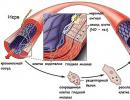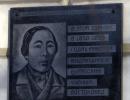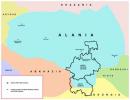Presentation - The history of Stonehenge - Stonehenge (in English). Presentation - History of Stonehenge - Stonehenge (in English) Download presentation on the topic of Stonehenge in English
Slide 1
Stonehenge
Stonehenge, one of the great Seven Wonders of the World
Slide 2

Great Britain
Slide 3

Back when Stonehenge was built people had no way of telling the time. Perhaps the Druids wished to keep records of events. Stonehenge is said by some to be one widespread sundial, a clock used in ancient times. When the sun rises it casts a shadow though an opening in the one side of Stonehenge, the day passes and the shadow move across the middle showing the druids the time of day.
Slide 4

It is located about 3 km west of Amesbury and 13 km north of Salisbury
The Stonehendge is in a county Wiltshire, in vicinities of Salisbury. The nearest motorways – A303 and A344/360. The nearest railway stations – Salisbury and Grejtli (approximately in 16 kilometers). From London it is necessary to go from Waterloo station by train to Salisbury (1.5 hours). Further at station in Salisbury it is possible to buy the ticket for the bus in a Stonehendge.
Slide 5

Gathering place for religions
Gathering place for religions
So taking into account that Stonehenge could predict eclipses another thought is that it was just used for predicting the full moon. The full moon meant new life, so perhaps they used Stonehenge for ceremonies to worship new life.
Slide 6

Nobody knows its precise purpose.
Slide 7

They say that it is connected with the sun and the moon.
The moon, it has been a sight for all over time. Back long ago little was none of the reasons for an eclipses, it was thought to be a sing from the gods. In a society which worshiped gods for all the mysteries of the world, the eclipse must have been very special. The builders of Stonehenge must have been marveled at the sight of this holy event, which happened every four years. Most likely the great Stonehenge was built to be a prediction device for the eclipse. Many people have studied Stonehenge and many have found that the stones are mathematically placed to show when and eclipse might occur. "In favor of this solution - that the Aubrey holes were used as a computer are these facts: the number 56 is the smallest number that measures the swing of the moon with an over-all accuracy of better than 3 days, and lunar cycles provide the only method of long-range eclipse prediction related to the seasons of the year."
Stonehenge is a prehistoric monument located in the English county of Wiltshire. One of the most famous sites in the world, Stonehenge is composed of earthworks surrounding a circular setting of large standing stones. It is at the center of the most dense complex of Neolithic and Bronze Age monuments in England, including several hundred burial mounds.
Stonehenge I The native Neolithic people of England began construction of Stonehenge I by digging a circular ditch using deer antlers as picks. The circle is 320 feet in diameter, and the ditch itself was 20 feet wide and 7 feet deep. they used the chalky rubble taken from the ditch to built a steep bank circle just inside the outer circle. Inside the bank circle, they dug 56 shallow holes known as the Aubrey holes. two parallel stones were erected at the entrance to the circle, one of which, the Slaughter Stone, still survives. Also surviving are two Station Stones, positioned across from each other on opposite sides of the circle, which may also have been erected during this time. Stonehenge I seems to have been used for about 500 years and then abandoned.
Stonehenge II Construction of Stonehenge II began around 2100 BC. A semicircle of granite stones known as bluestones was assembled within the original bank and ditch circles. The bluestones come from the Preseli Mountains in South Wales, nearly 250 miles away. There were about 80 of them, weighing up to 4 tons each. How they were transported is not known, although scholars don"t regard the feat as impossible and various theories have been presented. Second, the entranceway to the semicircle of bluestones is aligned with the midsummer sunrise. The alignment was continued by the clearing of a new approach to the site, "The Avenue," which has ditches and banks on either side like the original outer circle .
Stonehenge III Stonehenge III is the stone circle that is still visible today. During this phase, which was started in about 2000 BC, the builders constructed a circle of upright sarsen stones, each pair of which was topped with a stone lintel (horizontal capstone). The lintels are curved to create a complete circle on top. There were originally 30 upright stones; 17 of these still stand. Within stone this ring was erected a horseshoe formation of the same construction, using 10 upright stones. Here the trilithons stand separated from one another, in 5 pairs. Eight of the original ten stones remain. The horseshoe shape opens directly towards the Slaughter Stone and down the Avenue, aligned with the summer solstice sunrise.
John Aubrey was one of the first to examine the site with a scientific eye in 1666, and recorded in his plan of the monument the pits that now bear his name. William Stukeley continued Aubrey’s work in the early 18th century, but took an interest in the surrounding monuments as well, identifying the Cursus and the Avenue. The most accurate early plan of Stonehenge was that made by Bath architect John Wood in 1740.His original annotated survey has recently been computer redrawn and published. Importantly Wood’s plan was made before the collapse of the southwest trilithon, which fell in 1797 and was restored in 1958. Archaeological research and restoration.
William Cunnington was the next to tackle the area in the early 19th century. He excavated some 24 barrows before digging in and around the stones and discovered charred wood, animal bones, pottery and urns. William Gowland the first major restoration of the monument in 1901 which involved the straightening and concrete setting of sarsen stone number 56 which was in danger of falling. In straightening the stone he moved it about half a meter from its original position. Gowland also took the opportunity to further excavate the monument in what was the most scientific dig to date.
Richard Atkinson, Stuart Piggott and John F. S. Stone re-excavated much of Hawley's work in the 40s and 50s, and discovered the carved axes and daggers on the Sarsen Stones. in 1978 by Atkinson he discovered the remains of the Stonehenge Archer in the outer ditch. More recent excavations include a series of digs held between 2003 and 2008. This project mainly investigated other monuments in the landscape and their relationship with the stones - notably Durrington Walls. A new landscape investigation was conducted in April 2009. A shallow mound , rising to about 40 cm (16 inches) was identified between stones 54 (inner circle) and 10 (outer circle), clearly separated from the natural slope.In July 2010 the Stonehenge New Landscapes Project discovered what appears to be a new henge less more than 1 kilometer away from the main site.
Stonehenge (English: Stonehenge, lit. “stone henge”) is a megalithic structure in Wiltshire, England, which is a complex of ring and horseshoe-shaped earthen and stone structures. It is one of the most famous archaeological sites in the world.


Stonehenge was built at the turn of the Stone and Bronze Ages. Moreover, the creation of this amazing magical place took place in several stages. The first occurs around 3100 BC. It was then that a ditch and an internal earthen rampart were created in the form of a circle, with a diameter of 115 m, a width of 2.5 m and a height of 5080 cm. Almost a thousand years later, the “construction” of what would become the main foundation of Stonehenge began. 80 large stones were delivered to Salisbury Plain. They were installed inside the ditch in two concentric circles on the outer and inner sides of the semi-ellipse of triplets. A few more centuries later, a ring of thirty huge sandstone monoliths, 31 m in diameter, was erected. True, at present only 17 of them remain standing. Around 1800 BC, Stonehenge was again “reconstructed” and had already acquired the appearance we are familiar with.

The plan highlights: 1 Altar Stone, a six-ton monolith of green mica sandstone from Wales 2-3 Mounds without graves 4 Fallen Stone 4.9 meters long (Slaughter Stone scaffold) 5 Heel Stone 6 Two of the original four standing upright stones 7 Ditch (ditch) 8 Inner rampart 9 Outer rampart 10 Avenue, that is, a parallel pair of ditches and ramparts leading 3 km to the River Avon; now these shafts are barely visible 11, 12 Rings of 30 holes 13 Circle of 56 holes, known as Aubrey holes 14 Small southern entrance

It is difficult to establish the true purpose of Stonehenge since there are no inscriptions, marks, or anything at all on the ancient stones. One of the most common scientific theories about the purpose of Stonehenge says that it was most likely an ancient astronomical observatory, thanks to which priests could calculate lunar and solar days, mark the dates of important holidays, and so on.

Professor J. Mitchell, having carried out a computer analysis of Stonehenge and tried to restore the original appearance of Stonehenge using modern digital technologies, concluded that it is, no more and no less, an accurate cross-sectional model of the solar system. At the same time, ancient astronomers proceeded from the fact that there are not nine, but twelve planets in the solar system, two of which are located beyond the orbit of Pluto. And the third planet posed even more mysteries for the scientist, because it was supposed to be between the orbits of Mars and Jupiter, and in this place there is an asteroid belt.

It is also often claimed that Stonehenge was used for burials. After excavations, scientists came to the conclusion that in total about 240 people were buried in Stonehenge, who were cremated before burial. At the same time, archaeologists believe that most likely representatives of the local elite or the ruling dynasty were buried here.

The English writer and historian Tom Brooks, as a result of his many years of research, concluded that Stonehenge was part of a giant navigation system consisting of isosceles triangles, the top of each of which pointed to the next point


Back in the 20s of the last century, the famous geologist X. Thomas established. that the stones for the construction of the complex were delivered from quarries. which were located more than 300 kilometers from the construction site! Needless to say, transporting the giant stone blocks required incredible effort.

Thanks for watching. Sites that served as sources of material for the presentation:

Characteristics It is located in
Wiltshire, England.
It is a monument built
in the Neolithic and
Bronze Age.
Stonehenge is a large
circle of
standing stones.
How was it built?
FIRST STAGE
The first Stonehenge was a largeearthwork probably built around 3100 BC.
They formed a circle. Archaeologists found
cremated human bones, but they were
probably from part of a religious
ceremony
After that, the monument didn’t change
until 1000 years later.
SECOND STAGE
It started around 2150 BC. About 82bluestones from the Preseli mountains in
south-west Wales were brought to the site.
This journey was nearly 240 miles.
Once there, the stones were set up in the
center to make an incomplete double
circle.
THIRD STAGE
It started in 2000 BC. The Sarsen stonesthat they used were probably brought from
the Marlborough Downs area near
Avebury, about 25 miles north of
Stonehenge.
These were placed in an outer circle.
Inside the circle, there were also five
trilithons, that still remain today.
FINAL STAGE
After 1500 BC the bluestones were movedinto the horseshoe and circle that we see
today.
Most of the bluestones have been
removed or broken.
Possible theories about Stonehenge
Stonehenge was an astronomicalobservatory
They could predict eclipses, lunar phases and
seasons. Nevertheless, it was possible that it
was not the original function because it took
more than 1000 years to finish it.
Stonehenge was a cemetery
Scientists found human bones buried there.
Diapositiva 9
Stonehenge was a religious templePeople went there because the Druids
could give them magic power and cure
their illnesses.
Incredible theories
Stonehenge wasbuilt by Apollo's
followers who
lived in the north
of Europe and
were
documented in
Greek mythology.
Stonehenge
was a place
where UFOs
landed.
Diapositiva 11
Stonehenge wascreated in the first
years of the XX
century to attract
tourists.
Stonehenge was
built by the wizard
Merlin. He made it
himself by raising
the stones with his
magical power.
Vocabulary:
Bluestone-piedras del Stonehengetraídas de fuera
Bronze age -edad de bronce
(to) cremate -incinerar, cremar
Druid-Druida
Horseshoe-herradura
Neolithic-neolitico
Sarsen stone -piedra arenisca
Standing stone - megalito vertical
Trilithon -estructura de dos piedras
verticales (columnas) and una horizontal
apoyada en la verticales.
UFO -OVNI (objeto volador no identificado)
Wizard Merlin -El mago Merlin
1 slide

2 slide
Location of Stonehenge Stonehenge is a prehistoric monument located in the English county of Wiltshire about 3.2 kilometers west of Amesbury and 13 kilometers north of Salisbury.

3 slide
Plan of Stonehenge 1 = The Altar Stone, a six ton monolith of green micaceous sandstone from Wales 2 = barrow without a burial 3 = "barrows" (without burials) 4 = the fallen Slaughter Stone, 4.9 meters long 5 = the Heel Stone 6 = two of originally four Station Stones 7 = ditch 8 = inner bank 9 = outer bank 10 = The Avenue, a parallel pair of ditches and banks leading 3 km to the River Avon 11 = ring of 30 pits called the Y Holes 12 = ring of 29 pits called the Z Holes 13 = circle of 56 pits, known as the Aubrey holes 14 = smaller southern entrance

4 slide

5 slide
Astronomy and Stonehenge The prehistoric monument of Stonehenge has long been studied for its possible connections with ancient astronomy. Archaeoastronomers have claimed that Stonehenge represents an "ancient observatory," although the extent of its use for that purpose is in dispute. Many also believe that the site may have had astrological/spiritual significance attached to it as well. The discovery of evidence for a neighbor to the Heel Stone has challenged the interpretation of it as a midsummer sunrise marker. The second stone may have instead been one side of a "solar corridor" used to frame the sunrise.

6 slide
Druids Temple The theory that the Druids were responsible may be the most popular one; however, the Celtic society that spawned the Druid priesthood came into being only after the year 300 BC. Additionally, the Druids are unlikely to have used the site for sacrifices, since they performed the majority of their rituals in the woods or mountains, areas better suited for "earth rituals" than an open field.
7 slide
Stonehenge as a graveyard There is a theory that Stonehenge was used for burials. Indeed, burials were found on the monuments territory, but they were made much later after Stonehenge had been built. According to news reports, a professor of archeology from the University of Sheffield, Mike Parker Pearson, who manages the Stonehenge Riverside Archaeological Project noted that in his opinion Stonehenge from the very beginning of its existence and to flourish in the third millennium BC was considered by inhabitants of England as an area for the burial of the dead.

8 slide
Legends Many early historians were influenced by supernatural folktales in their explanations. Some legends held that Merlin had a giant build the structure for him or that he had magically transported it from Mount Killarausin Ireland, while others held the Devil responsible. Henry of Huntingdon was the first to write of the monument around 1130 soon followed by Geoffrey of Monmouth who was the first to record fanciful associations with Merlin which led the monument to be incorporated into the wider cycle of European medieval romance. According to Geoffrey's Historia Regum Britanniae, using his magic Merlin took the circle from its original place in Ireland at the behest of Aurelius Ambrosius to serve as an appropriate burial place for Britain's dead princes.

Slide 9
Conclusion It's difficult to judge which of the theories is correct, but from what I have read I can do the conclusion that Stonehenge is the most mysterious symbol of Britain, which went through the whole history with this country and gives it special charm of mystery and unexploredness.






